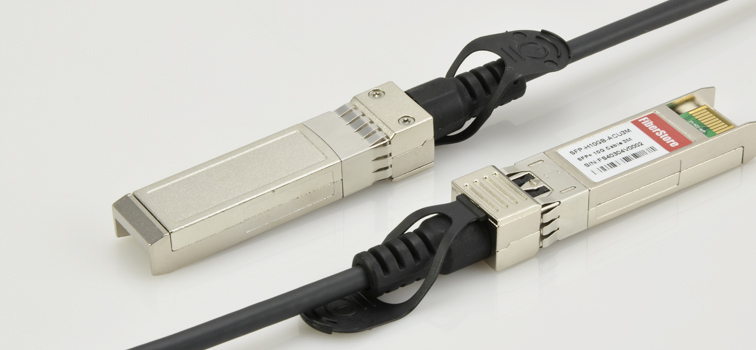Today, 10G SFP+ direct attach cable (DAC) becomes cloud computing and cloud storage mainstream primary connection tool, but what is a direct attach cable? For this, different manufacturers of DAC cable have different presentations and descriptions. And here, we’ve got a number of related information together, mainly to discuss what exactly SFP + direct attach cable is and its other details, as well as discuss the advantages and disadvantages between active and passive SFP + DAC cable.
The 10G SFP+ direct attach cable option is defined for 10G applications over copper cable. The 10G SFP+ DAC link utilises a receive equalizer from the host PHY/SerDes to be able to compensate for the Inter Symbol Interference (ISI) introduced by the cable. Electrical and mechanical specifications for SFP+ optical modules, 10G SFP+ direct attach cable, and hosts are defined in the SFF-8431 specification developed by the SFF Committee, with broad industry participation.
10G SFP+ direct attach cable is made from the inexpensive copper twinaxial cable with SFP+ connectors on both sides based on SFP+ MSA (multi-source agreement). It uses SFP+ connectors for 10G links instead of utilising an optical transceiver on each and every end as well as a length of fibre optic cable. It takes away the expensive optical lasers along with other electronic components. For both active and passive 10G SFP+ DAC cables, a smaller electrical component is used to recognize the SFP+ module and cable type to the Ethernet interface. 10G SFP+ direct attach cable is known as the successor technology to 10GBASE-CX4. It has the advantages of low power, low cost, low latency with the more benefits of having the small form factor of SFP+, and thinner, more flexible cabling compared with 10G SFP+ transceivers. Due to the distance limitation, the target application of 10G SFP+ DAC is interconnection of top-of-rack switches with application servers and storage devices in a rack.
Vendors provide both active and passive versions of the 10GSFP+ direct attach cable. 10GSFP+ SFP+ DAC assembly is recognized as active in case there are signal processing electronics in the SFP+ module to increase signal quality and supply a longer cable distance. So the active direct attach cable can make it a possibility to support longer and thinner cable assemblies. The lower priced approach is the passive direct attach cable, which has a tendency to be shorter. Active 10G SFP+ DAC has a 10m distance limitation and passive 10G SFP+ DAC ranges from 1 m to 7 m. But you may discover variations in supported cable lengths among different vendors.
Passive 10G SFP+ direct attach cable is much less costly but require the host to do the work of driving it properly.
Benefits:
- Lower Costs
- Higher Reliability
Tradeoffs:
- No LOS
- No TX Disable
- No Interrupts
- Limited Management Interface
- Host must drive Cu cable
Active 10G SFP+ direct attach cable provides the added benefit of being “optical-module” like.
Benefits:
- Enhanced Signal Integrity
- Longer Cable Lengths
- Transmit Pre-emphasis
- Active/Adaptive Receive Equalization
- Tx Disable
- Loss of Signal (LOS)
- Interrupts
- Management Interface
- Looks like an optical module
- Don’t have to worry about host Tx/Rx for Cu cables
Tradeoffs:
- More Expensive
This low-cost 10G SFP+ DAC is beneficial, as an example, for interconnecting a collection of switches, as well as for short-distance connections between switch ports and Ethernet interfaces on servers as well as other devices. Before the growth and development of 10GBASE-T, it was the only real low-cost copper connection designed for 10 Gbps operation. For active and passive 10G SFP+ DAC, each has advantages and disadvantages. You can select according to your special needs. You can also get 10G SFP+ direct attach cable of various compatible brands from here.
Related Article: 10GBASE-LRM vs. 10GBASE-LX4, Which One Wins?

